
by Legalnaija | Apr 26, 2021 | Uncategorized
Introduction:
I have often wondered which would be superior in the coming years, Human Intelligence or Artificial Intelligence, and a key contemplation on this subject is which would take control over the other? We have heard experts repeatedly talk about how Artificial Intelligence has significantly been integrated into our daily lives, and any attempt by us to thwart this integration, if at all remotely possible, would be akin to reversion to the dark ages again.
To give us a glimpse of what we could expect, a lot of movies have stretched our imagination on the extent to which this technology is going to affect everything and anything. A recent movie that is quite related to this subject is the Hollywood blockbuster; Godzilla Vs Kong. The movie which was directed by Adam Wingard illustrates a battle for supremacy between two Alpha mythical beings called “Titans”. A group called APEX in a bid to prove that humans must remain superior created a giant robot (Mechagodzilla) to battle these titans and we know how the robot fared in the end.
The boggling questions then are; are we superior? If yes, can we stay superior? If no, how can we come back on top? In all these, a critical role amongst key stakeholders that must not be overlooked and cannot be overstressed is the role of Regulators.
This piece critically discusses the concepts of intelligence vis-a-vis the meanings of both artificial and human intelligence, the interconnection that underlies their functionality in the general scale of our existence, the grapple for supremacy and what it portends for the future, as well as the indispensable role of regulators in finding a workable balance between them.
What is Intelligence?
Biologically speaking, a narrow and simplistic way to define Intelligence is that it is the ability to think, to learn from experience, to solve problems, and adapt to new situations. Think about our world and the several unique creatures in it. We can agree, unbiased, that humans are the most complexly intelligent creatures currently roaming this planet. We have even figured out a way to measure our intelligence, including that of other animals just to prove that we are more intelligent. There are significant gaps, in terms of intelligence and complexity between the brains of a worm, a chicken, an ape, and an adult human. However, in recent times we see a potential contender — Artificial Intelligence (AI).
What is Artificial Intelligence (AI)?
AI just like every concept is devoid of a uniform definition. However, in simple terms, Investopedia concisely expressed it to mean “the simulation of human intelligence in machines that are programmed to think like humans and mimic their actions.” Let’s agree for our purpose that “Intelligence” is purely about information processing and the faster and more efficiently an entity can process information to give a precise result, the more intelligent that entity is.
An undeniable attribute of this human creation called Artificial Intelligence is that it is already performing more highly efficient and accurate specific operations than humans can perform, and we are certain that these specific creations, pieced together, will very soon surpass human intelligence. We simply are working on the tools that will create a foundation for the (true, “Super Intelligent”) AI.
For a comprehensive understanding, in terms of complexity, there are different forms of AI.
These different forms are either Strong AI or Weak AI. The results of creating software and algorithms under these categories have brought about categorising AI as Reactive Machines, Limited Memory, Theory of Mind, Self-aware, Artificial Narrow Intelligence (where we currently are), Artificial General Intelligence, and Artificial Superintelligence.
I will not argue whether or not we are at the brink of an “Age of Ultron” scenario, I would however agree that we are slowly reaching the level of creating such an intricately mesmerising entity. With Machine Learning at its full potential, we will witness AI on a seamless autopilot. But before we get there, our imaginations can only run wild on the extra opium fed to it by Hollywood Thriller movies.
Limiting our experience to what we have today, mostly Artificial Narrow Intelligence, we see our computers increasingly perform simple tasks better than we normally would. Take for instance your Google Maps, it practically knows every street name, how to get there and approximately how long it would take to get there. Relying on a similar information database are self-driving cars and semi-autonomous drones, these technologies have in some cases proven to make better judgements than their human counterparts.
We must not fail to mention AlphaGo — the highlight of AI development history. AlphaGo, a Google DeepMind project is an AI agent that is specialized to play Go (a Chinese strategy board game) against human competitors. In a test, after 72 hours of supervised learning, the AI beat the human world champion, Kie Jie. The next even more significant move was the creation of AlphaGo Zero. This AI was capable of teaching itself to play the game and after much practise against itself, beat its predecessor.
Another significant example of this type of AI is Sophia. Sophia is a realistic humanoid robot capable of displaying human-like expressions and interacting with people. While a few writers have oversimplified its existence to be like a chatbot with a face, it truly is a wonder to observe. It is even a citizen of Saudi Arabia. I like to call it the marriage between AI and Robotics [maybe a pre-evolved Ultron].
Perhaps the most significant development in this AI form is OpenAI’s GPT-3. GPT-3 is a creation of OpenAI, a research business co-founded by Elon Musk and has been described as the most important and useful advance in AI for years. This AI is capable of generating an essay in a few seconds, answering any question, generating music, creating designs, and building software components, translating to and from a variety of languages, knows billions of words, and is even capable of coding! Because of all the data GPT-3 has at hand, it requires no further training to fulfil language tasks.[1] Put simply; it’s an AI that is better at creating content that has a language structure – human or machine language – than anything that has come before it.[2]
The Risks and Control Mechanisms
Stephen Hawking and Elon Musk share similar thoughts on Superintelligent AI being the greatest feat man could ever attain, however, it could be the ultimate cause of our extinction if not properly checked and managed.
As Elon Musk puts it, “AI will be the best or worst thing ever for humanity.” The reassuring thing about the level of AI development we have today is that it is currently not capable of engineering itself and it is nowhere near human intelligence. And while we are still far away from what would potentially evolve into Artificial Super Intelligence, what we have today is only narrow, can only process huge amounts of data and provide results on specific tasks with little or no human intervention. Consequently, I believe the technology is at its incubation. It is then imperative that this technology along with its infinite possibilities be properly understood and in the best way, regulated so as to prevent the risks of a rogue or runaway Super Intelligence. In other words, control it from its infancy.
On preventing the technology from eventually causing our extinction, several solutions have been theorised. One of such solutions is to isolate the technology and keep it confined in a “box”. This could mean isolating it from accessing the internet, limiting its contact with the outside world. The problem this would inevitably birth is a great reduction of its ability to perform the functions for which it was created.
Another solution is to design a “theoretical containment algorithm” to ensure that an artificial intelligence “cannot harm people under any circumstances.” However, an analysis of the current computing paradigm showed that no such singular algorithm can be created. Another one that is radical but seems to be working is implanting this technology in human brains. This will facilitate an efficient control of the technology.
Regulations and the Roles of Regulators
Whichever way we decide to solve this problem, one key aspect must not be overlooked — the role of Regulators. We have seen good attempts by various jurisdictions to keep up with regulating the emerging trends in technology and more particularly, Artificial Intelligence. Some countries have managed to develop regulations and guidelines targeted towards ensuring that the wide haze of AI is kept under close watch while still adapting it to meet the crucial and ever-expanding human needs as the world dives into the future.
In June 2018 the European Commission set up the independent High-Level Expert Group on AI to provide guidelines on how AI can achieve a unique degree of reliability.
In light of the guidelines, the Commission has since published its own ‘White Paper on Artificial Intelligence – A European approach to excellence and trust – on 19 February 2020. The Commission’s White Paper outlined that the most alarming risks to be addressed concerning AI are those it poses to the landscape of fundamental rights, the privacy of data, safety and effective performance, and liability identification. The Commission insists that the optimal method of regulation should be risk-based to ensure that reactions to AI development are commensurate with and do not stifle innovation.
In place of proposing regulations at this level, the Commission has laid out some legal requirements which must be captured by any regulatory framework to ensure that AI continues to be dependable, and subjective to the values and principles of the European Union.
Following this White Paper, the EU recently projected that its draft regulation will be released on 21 April 2021.
On 21 April 2021, the European Commission adopted a proposal for a regulation of AI Systems, one which it describes as “the first-ever legal framework on AI.” The AI Regulation will impose significant obligations impacting businesses across many, if not all, sectors of the economy. The AI Regulation will prove controversial, touching off a legislative battle lasting at least until 2022.
The proposed AI Regulation will join other ambitious EU initiatives in the digital sector, such as the Data Governance Act, Digital Services Act and Digital Markets Act, currently working their way through the EU legislative process, as well as the forthcoming Data Act and the ongoing reform of EU antitrust policy. Some of the AI Regulation provisions read across to related provisions in other measures – for example, the practices prohibited for all AI systems (see below) are related to the Digital Services Act measures to combat harmful content on the Internet.
The AI Regulation defines “AI systems” broadly and imposes tailored obligations on actors at different parts of the value chain, from “providers” of AI systems to manufacturers, importers, distributors and users. The AI Regulation imposes especially strict obligations concerning “high-risk AI systems.”

On the other hand, the AI Regulation includes several provisions intended to promote the development and uptake of AI systems in the European Union (EU). The AI Regulation also creates a new regulatory framework, with a European Artificial Intelligence Board overseeing and coordinating enforcement. The AI Regulation envisages a two-year period for application following adoption and publication of the final regulation, meaning that the new requirements could apply as early as 2024.[3]
United States lawmakers and regulators have mainly pursued AI in the area of autonomous or self-driving vehicles. The Department of Transportation is investigating what elements must be considered in drafting regulations for the use of such vehicles, including multi-vehicle convoys, and several states have adopted legislation and regulations allowing for the testing of autonomous vehicles. Also, recent federal legislation has tasked part of the Department of Defense with the responsibility of crafting policies for the development and deployment of AI systems as they concern national defence.
In the 115th Congress, thirty-nine bills have been introduced that have the phrase “artificial intelligence” in the text of the bill. Four of these bills have been enacted into law. Section 238 of the John S. McCain National Defense Authorization Act for Fiscal Year 2019 directs the Department of Defense to undertake several activities regarding AI.[4]
General Discussions on regulation of AI in the United States have included topics such as the timeliness of regulating AI, the nature of the federal regulatory framework to govern and promote AI, including what agency should lead, the regulatory and governing powers of that agency, and how to update regulations in the face of rapidly changing technology, as well as the roles of state governments and courts.
In January 2019, following an Executive Order on Maintaining American Leadership in Artificial Intelligence, the White House’s Office of Science and Technology Policy released a draft Guidance for Regulation of Artificial Intelligence Applications, which includes ten principles for United States agencies when deciding whether and how to regulate AI.[5]
In May 2018, the Trump Administration held a summit on AI technologies for industry, academia and government participants. At this conference, White House officials outlined the following four core goals of the U.S. government concerning AI technologies: (i) maintaining American AI leadership; (ii) supporting American workers; (iii) an increased focus on research and development; and (iv) removing barriers to innovation. In February 2019, President Trump followed up on these previously stated goals by signing an executive order to create the “American AI Initiative”, which, amongst other things, directs heads of federal agencies to budget an “appropriate” amount of funding for AI research and development.[6]
Australia has been and remains a leading participator in the ongoing discourse on the regulation of AI, attracting different bodies seeking to provide comments as to the optimal model to AI regulation:
The Australian Human Rights Commission equally published a White Paper in 2019 calling for comments on the proposed method of regulation. The paper proposes that a separate regulatory body be established, either out of an existing organisation or an entirely new body, to be known as a ‘Responsible Innovation Organisation’. This body would be saddled with the mandate of guiding the approach to AI and likely be conferred with enforcement powers to see to it that AI is put to appropriate use, in line with Australian law and some vital governing principles
As it stands, however, Australia has also no specific regulatory framework for the development and use of AI and therefore placing heavy reliance on the existing legislation and standards pending when new standards will be birthed. It appears that given the depth of discussion papers and the existence of a current set of AI principles, Australia may not be a long way off an AI-specific regulatory cum legislative instrument.
The UK has queued up in taking an affirmative step to the development of AI, with a concentration on the encouragement of innovation in the sector.
In February 2020, the Committee on Standards in Public Life published ‘Artificial Intelligence and Public Standards’ commenting on the role of public standards in the AI sector. According to the Committee, the current tools and principles established in the UK are sufficient to encapsulate the risks that come with AI development. It is not a matter of establishing new regulatory bodies and laws but instead clarifying and tweaking current laws and standards so they can be more clearly applied to circumstances involving AI.
The UK government recently established the Centre for Data Ethics and Innovation (CDEI) as a specific statutory body aimed at researching issues of AI and its regulation. The CDEI often publishes papers and reports on the status of AI regulation within the UK on their website.
In July 2017, China’s State Council released the Next Generation Artificial Intelligence Development Plan (Development Plan). The Development Plan sets forth long-term strategic goals for AI development in China, concluding in 2030. It contains “guarantee measures,” such as developing a regulatory system and strengthening intellectual property protection, in promoting AI development. Regulation of the issues of ethical and legal support for the development of AI is nascent, but policy ensures state control of Chinese companies and over valuable data, including storage of data on Chinese users within the country and the mandatory use of People’s Republic of China’s national standards for AI, including over big data, cloud computing, and industrial software. The Development Plan comprises three stages, concluding in 2020, 2025, and 2030, respectively, and sets forth goals concerning building a regulatory framework and ethics framework for each stage. [7]

An in-depth analysis exposes an interaction between Artificial Intelligence in Nigeria and the Copyright Act. AI-related applications will usually run on software. However, it is important to note that there are no provisions for the protection of software under the Copyright Act in Nigeria.
Copyright protection arguably only extends to the original documented expression of the software. This original expression does not extend to the functionality of the software. It is only limited to the blueprint either in audio, written or any other form permissible by the Copyright Act as being protectable thereunder.
Any sufficiently transformative technology is going to require new laws. This, therefore, means that the rapidly advancing area of artificial intelligence will require a new field of law and new regulations. Artificial development is developing fast and needs to be regulated, as it is, there is little or nothing on the regulation of AI in the world and Nigeria particularly. As stated in the previous section efforts are being made by the European Union to ensure that a new category of persons ‘electronic persons’ are created to cater for artificial intelligence and robots. This is laudable as it will create a platform to attribute rights and obligations to AI systems and robots. The application of Artificial Intelligence in Nigeria is still at an infancy stage and the deployment of AI in the administration of Intellectual Property and other spheres of law in Nigeria in a few years may happen sooner than we think. These may be centred around the Law of Torts to handle liabilities arising out of wrongful acts of these machines, fundamental rights, contracts law, Data Protection, Anti-Terrorism and Technology Law among others.
But like any other technology, AI is a double-edged sword. According to futurist Ray Kurzweil, “if the technological singularity happens, then there won’t be a machine takeover. Instead, we’ll be able to co-exist with AI in a world where machines reinforce human abilities”. While speaking on AI’s Existential threat to humanity, Elon Musk said, “AI is a rare case where I think we need to be proactive in regulation than be reactive.” And again. “I am not normally an advocate of regulation and oversight…I think one should generally err on the side of minimizing those things…but this is a case where you have a very serious danger to the public.”
Though we are years away from ASI, researchers predict that the leap from AGI to ASI will be a short one. No one knows when the first sentient computer life form is going to arrive. But as Narrow AI gets increasingly sophisticated and capable, we can begin to envision a future that is driven by both machines and humans; one in which we are much more intelligent, conscious, and self-aware.[8]
CONCLUSION
In my opinion, one way to move forward in terms of regulating AI to ultimately prevent it from causing harm to man is for us to proactively create comprehensive regulations both locally and globally to control the creation and application of this technology. The key control issue is responsibility. We cannot always count on expert groups to stay responsible with their creations. As a result, we must timeously create regulations that will balance the interest of the public and innovators. A globally agreed set of rules cannot be overlooked also. We can have an international body where all countries can be represented and this body will be responsible for creating rules that will strike a balance between the interests of the public and innovators, the ultimate goal being to keep us in control of our creation.
[1] Clockwise Software, “GPT-3 Is Only the Beginning: Intro to Language Model’s Capabilities” (Clockwise Software, December 2020) <https://clockwise.software/blog/what-is-gpt-3/> Last accessed 14 April 2021
[2] Bernard Marr, “What is GPT-3 and why is it revolutionising Artificial Intelligence?” (Forbes, October 2020) <https://www.forbes.com/sites/bernardmarr/2020/10/05/what-is-gpt-3-and-why-is-it-revolutionizing-artificial-intelligence/?sh=1fd1c3f7481a> Last accessed 15 April 2020
[3] Norton Rose Fulbright, “EU proposes new Artificial Intelligence Regulation” (Norton Rose Fulbright, April 2021) <https://www.nortonrosefulbright.com/en/knowledge/publications/fdfc4c27/eu-to-propose-new-artificial-intelligence-regulation> Last Accessed 23 April 2021
[4] Library of Congress, “Regulation of Artificial Intelligence: The Americas and the Caribbean” (LOC, December 2020) <https://www.loc.gov/law/help/artificial-intelligence/americas.php#_ftn67> Last Accessed 17 April 2021
[5] Lee Tiedrich, “AI Update: White House Issues 10 Principles for Artificial Intelligence Regulation” (Inside Tech Media, January 2020) <https://www.insidetechmedia.com/2020/01/14/ai-update-white-house-issues-10-principles-for-artificial-intelligence-regulation> Last accessed 17 April 2021
[6] Nathan Greene, David Higbee, Brett Schlossberg, “Ai, Machine Learning & Big Data 2020 | USA” (Global Legal Insights, 2020) <https://www.globallegalinsights.com/practice-areas/ai-machine-learning-and-big-data-laws-and-regulations/usa> Last accessed 17 April 2021
[7] The Library of Congress, “Regulation of Artificial Intelligence: East/South Asia and the Pacific” (LOC, December 2020) <https://www.loc.gov/law/help/artificial-intelligence/asia-pacific.php#_ftn30> Last accessed 17 April 2021
[8] Tanya D. Jajal “Distinguishing between Narrow AI, General AI and Super AI” (Medium, May 2018) <https://medium.com/mapping-out-2050/distinguishing-between-narrow-ai-general-ai-and-super-ai-a4bc44172e22> Last accessed 17 April 2021
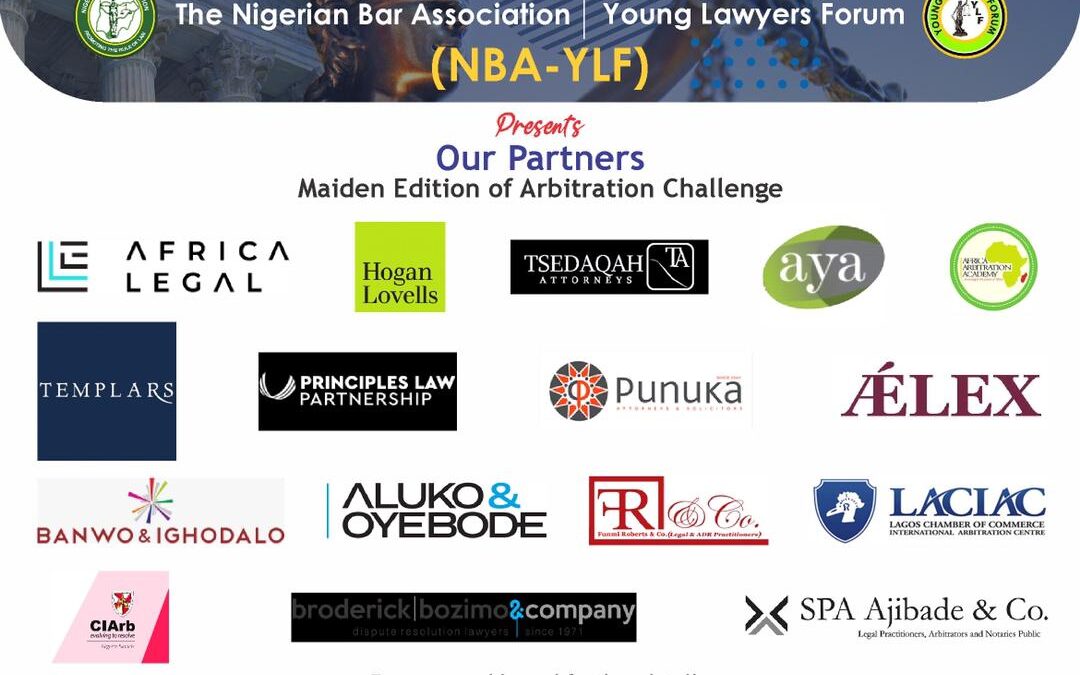
by Legalnaija | Apr 24, 2021 | Uncategorized
The Young Lawyers Forum (“YLF”) of the Nigerian Bar Association (“NBA”) officially announced the maiden edition of on August 5, 2020. The Arbitration Challenge, which is the first of its kind in Nigeria, provides an opportunity for young lawyers to learn and apply key principles in international commercial arbitration, interpret the various texts of international commercial law found in various foreign investment agreements, and consequently, hone their writing and oral advocacy skills.
Registration of NBA branch teams for the Arbitration Challenge commenced on August 5, 2020, and officially closed on September 15, 2020. The Dispute Scenario Problem (insert hyperlink) and the Rules (insert hyperlink) for the Arbitration Challenge were published to the participating teams on November 23, 2020.
The participating teams’ memoranda in support of both the Claimant and Respondent’s position were received by the Arbitration Challenge Committee on January 25, 2021, and assessment of their entries is currently being finalized by leading arbitration practitioners.
The NBA – YLF Steering Committee on Arbitration is pleased to announce that the list of successful participating teams to proceed to the oral rounds will be announced on April 26, 2021. The successful teams will participate in the next phase of the challenge – virtual regional rounds, and thereafter, semi final rounds scheduled to hold on April 29 and 30, 2021 respectively, where participants will be tested on their oral advocacy skills by leading arbitration experts.
The Oral finals of the Arbitration Challenge shall be held on the 15th of May 2021.
Our heartfelt appreciation goes to our esteemend partners and sponsors and we look forward to an exciting oral rounds of the YLF Arbitration Challenge.
For further enquiries about participation and support, kindly send an email to aadebesin@olaniwunajayi.net and copy tobiadebowale@nigerianbar.ng.
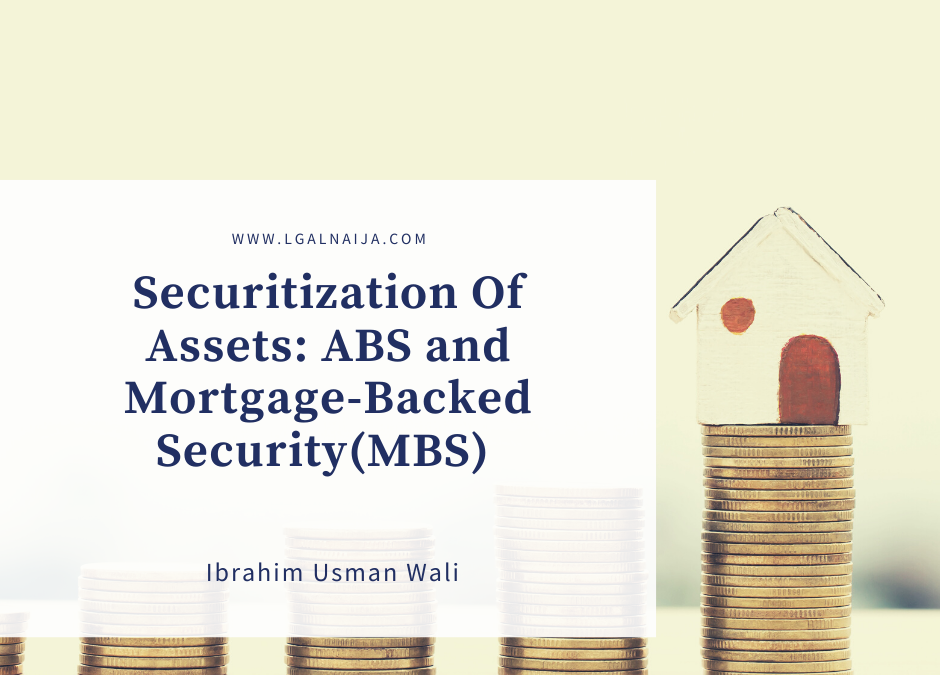
by Legalnaija | Apr 22, 2021 | Uncategorized
In this brief primer, we will discuss the concept of securitization and the basis for their use, as well as their impact on the economy.
1.0 The Concept of Securitization.
Securitization is well established and practiced in the global debt capital market. Some sources describe it as the practice where issuers merge different financial assets into one unit, thereby creating a single financial instrument.
Securitization is a process by which a company assembles its different financial assets/debts to form a consolidated financial instrument which is issued to investors.
Similarly,it is the process of selling assets and generating cash flows from a companyto another company specifically set up for that purpose. Subsequently, the receiving company issues out notes to the company from which the assets or cash flow generated was received. The cash flows from the sale of the assets back up these notes.
Securitization has also been employed as part of asset and liability management, inhandling balance sheet risks. Sundaresan defines it as:
“A framework in which some illiquid assets of a corporation or a financial institution are transformed into a package of securities backed by these assets, through careful packaging, credit enhancements, liquidity enhancements and structuring.”
The practice of securitizationallows institutions like Corporates and Financial Institutions to modify the assets that cannot be readily marketable to rated securities tradeable in the secondary markets. Residential mortgages and car loans are a typical example of these types of assets. This allows investors to gain access to these types of original assets which would not have otherwise been accessible. This merger and packaging process creates asset-backed bonds, which are debt instruments created from a smorgasbord of loan assets from which interest is payable on a floating basis.
2.0 ESSENCE OF SECURITIZATION?
The fundamental reason behind securitization is the need for institutions to derive value from the assets on their balance sheet. These assets could be residential mortgages, corporate loans, debt instruments, among others.
Some of the factors that necessitate securitization include:
- Where size of assets is decreasing and revenues are not realised from them, it could lead to an increase in the return on equity ratio.
- The capital expended in managing balance sheets would reduce, which will aid costs savings and allow the institution to put the capital in another profitable venture.
- The interest payable on Asset-backed securities is usually lesser than other underlying loans, therefore creating surplus cash for the original entity.
Summarily, banks securitize for three reasons; funding its own assets, managing its balance sheet, and risk management.
The benefits of securitization to investors in the ABS market is considerably high. Through ABS, investors can diversify their risk and sectors of interest, they can access an array of risk-reward profiles and importantly, access markets that are otherwise closed off for them. Securitised notes habitually offer a better risk-reward performance than corporate bonds of the same maturity and therefore offer assurance to investors.
3.0 The Securitization Process
The securitization exercise involves different components. There is the original company or institution (the originator) whose assets are being securitized. The process involves an issuer buying off these assets from the originator. This issuer is usually an SPV created specifically for that purpose and is usually domiciled off shore. The purpose of the SPV is to ensure that these assets are held separate from the other assets of the originator. So for instance, where the originator is declared bankrupt or is facing a liability claim, the assets in the SPV would not be affected. This is called being ‘bankruptcy-remote’. On the other hand, if the assets in the SPV do not yield, investors cannot claim against the originator. Where these assets are held in an SPV structure, the financial ratings of the originator become totally irrelevant to the bond-holder.
The process also involves credit enhancements, where a third party guarantees the credit quality of the SPV, therefore giving the issued notes strong investment grade ratings. The SPV is structured in a way that the issued notes carry lower costs than the assets of the SPV. This allows the originator to secure lower-cost funding otherwise unavailable in the unsecured markets. This is particularly more beneficial for institutions with a low credit rating.
4.0 Mechanics of Securitization
Securitization reflects a true sale of the assets of an originator on its balance sheet. This is why the SPV, being a separate legal entity is required to play the role of note issuers. The securitised assets are sold into the SPV’s balance sheet, and therefore divorced from that of the originator. The process involves:
- Due diligence on the prospects of the assets
- Setting up an SPV and transferring of assets to it
- Underwriting of loans for credit quality and servicing
- Determining the nature and structure of the note; is it going to be issued in series or at once
- Rating of the notes by one or more credit rating agencies
- Placing the notes on the capital market.
In order for the transfer of the assets to the SPV to be legally recognised, the assets must be ‘sold’ to the SPV. Another major consideration for an originator is the choice of its underwriting bank, who will have to structure the deals and place the notes.
5.0 SPV structures:
There are usually three types of securitization structures being employed; amortising, revolving and the master trust.
5.1 Amortising Structures
The Amortizing Structure, which simply means periodicalpays off of principal and interest, pays the principal and interest to investors on a coupon-by-coupon basis throughout the lifespan of the security. Their pricing is subject to their expected maturity. This is also called the pass-through structure, and are more commonly used in residential and commercial mortgage backed deals.
5.2 Revolving Structures
The Revolving Structure is designed in a way that allows for the principal of the assets to be revolved. The collections on the principal are used to purchase new receivables that fulfil the necessary criteria. This structure is usually used for short term assets having high pre-payment speed, such as credit card debts and car loans. Principal payments are paid to investors either in a series of instalments in equal value or as a lump sum at the maturity of the notes.
5.3 Master Trust
Master trusts are more frequently used in the United States and the UK. It allows a single SPV to issue multiple securitizations. The originator transfers the assets to the master SPV, where then notes are issued out of the asset pool based on the investorv’s demand. It is mostly used by mortgaged based securities and credit card ABS originators.
6.0 Credit Enhancement
The credit strength of the SPV and the backed assets are vital in influencing investor decisions. Credit enhancement are measures initiated so that the issue notes acquire the necessary credit status to woo in investors. It can be done through the following means:
- Over-collateralisation: – where the value of the asset is more than the value of the issued notes.
- Pool insurance: – an insurance policy from a reputable insurance firm to cover the risks around the pool.
- Classification of notes: – notes can be classed into junior and senior classes where the notes of a junior class owner is subordinated to the rights of a senior owner.
- Margin step – up: – a number of issuers include a step-up feature in the coupons, which served as incentives for investors.
- Excess spread: – excess spread is usually the difference between the interest payable on a note and the return on the underlying assets. These are periodically used to cover expenses and losses.
Whichever structure is used; the cash waterfall process remains the preferred return model. All cash generated by the asset pool is paid in order with pre-arranged payment priority. Senior obligations are met before the junior ones. An independent valuation expert is usually retained to value the asset and determine whether it can service all the vehicle’s obligations.
7.0 Impact on balance sheet
Securitization has an effect on the liability side of an originator’s balance sheet. From the process, some identified assets have been removed from the balance sheet, although the originator retains the first-loss piece. The first-loss amount is then deducted from the originator’s capital position. For example, let’s imagine a bank has N100 million worth of assets that have been risk-weighted, with a target Basel ratio of 12% (under Basel III, the minimum capital ratio a bank must maintain in 8%, but they prefer to set aside an amount in excess), and it goes on to securitize the entire N1oo million worth of assets. It retains the first-loss series which is 1.5% of the total issue. The other 98.5% is then sold in the market. The bank still has 1.5% of the capital reserved against possible future losses, but is now free of the remaining 10.5% of the capital.
8.0 Conclusion
Securitisation occurs where some assets of a company are lifted from its balance sheet and are funded by third party investors. The investors in return, receives financial instruments evidencing the investment and doing away with a lending institution. As derivatives of the conventional secured debt instruments, structured financing instruments are supported by a lien on selected assets or by a credit enhancement scheme such as a guarantee. In traditional secured bonds, the primary source of repayment of the bond remains the liquidity and cash flow of the issuer. With securitised transactions, that burden of repayment on the bonds shift from the issuer to a pool of assets which have been securitised.
 Written by: Ibrahim Usman Wali
Written by: Ibrahim Usman Wali
PROFESSIONAL EXPERIENCE
Ibrahim is an associate at Omaplex Law Firm and member of the Capital Markets team of the firm. He covers a range of securities products, including debt and equity, high yield, structured finance and derivatives, securitization, corporate trust among others. He has advised high profile clients comprising global investment banks, SEC and Nasdaq-listed corporates, sovereigns and private individuals alike.
ibrahim.wali@omaplex.com.ng
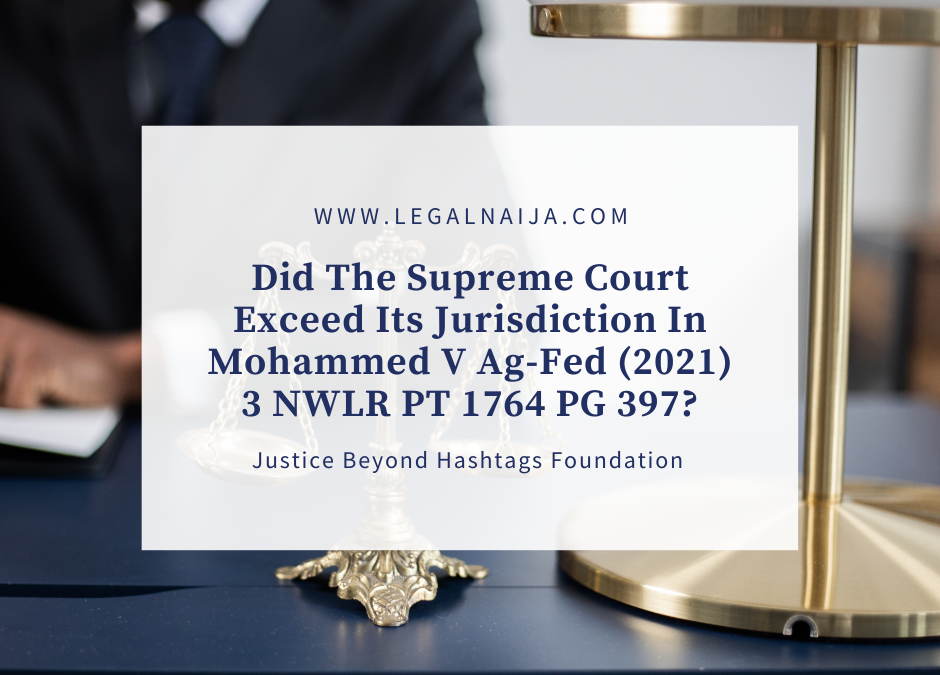
by Legalnaija | Apr 20, 2021 | Uncategorized
The recent decision of the Supreme Court in the case of Mariam Mohammed (a.k.a Mama Blessing) V Attorney General of the Federation reported as Mohammed v. A-G, FED (2020) LPELR-52526(SC) and Mohammed v A.G Fed (2021) 3 NWLR PT 1764 pg 397, wherein the Apex Court affirmed the conviction of the Appellant who was charged with offence of human trafficking for prostitution and increased the sentence imposed by the trial Court has stirred up debates among legal practitioners and scholars. References to excerpts of the reported judgment in this article shall be to the Law Pavilion Electronic Law Report (LPELR).
The Apex Court in its lead judgment delivered by the Noble Lord Kekere-Ekun JSC increased one of the sentences passed on the unsuccessful Appellant by the trial Court from 3 years imprisonment to 10 years. This has been bemoaned as being ‘ultra vires’ in some quarters, as some practitioners are of the opinion that the Apex Court exceeded its jurisdiction when it set aside a sentence dished out by the trial Court and affirmed by the Court of Appeal on the premise that the sentence was not appealed against by any of the parties involved.
It has become necessary to examine the facts, holding and reasoning of the Apex Court in this case, to determine whether the contention of critics are indeed correct, or whether the Apex Court acted within its jurisdiction in dishing out its judgment.
The facts which gave rise to this appeal are not convoluted. The Appellant and her co-accused were charged before the Federal High Court, Ikeja Judicial division for allegedly involving in the trafficking of a victim, one Mary Joseph from Lagos to Libya where she was sold and coerced into the prostitution. The Accused persons were charged on three counts of offences namely: Procurement of the victim for prostitution contrary to section 15(a) of the Trafficking in Persons Prohibition Law Enforcement and Administration Act, 2003; organization of foreign travel for the victim for the purpose of prostitution contrary to section 16 of the Trafficking in Persons Prohibition Law Enforcement and Administration Act, 2003; and deceitful inducement of the victim contrary to section 19(b) of the Trafficking in Persons Prohibition Law Enforcement and Administration Act, 2003 respectively. The Accused persons pleaded not guilty at the trial.
The material section to our discourse, Section 19(b) of the Trafficking in Persons Prohibition Law Enforcement and Administration Act, 2003 provides that:
“(1) Any person who
(b) by force compels or by any deceitful means – induces any person to go from any place, commits and offence and is liable on conviction, to imprisonment for ten years or to a fine not exceeding N200,000.00 or both.”
At the conclusion of the trial, the trial Court found the Appellant guilty on all counts while her co-accused was found guilty on counts 1 and 3 only. On 5/10/2011, the trial Court sentenced the Appellant to 14 years imprisonment without the option of fine on count 1, 10 years imprisonment without the option of fine and on count 2, and 3 years imprisonment on count 3. The sentences were to run concurrently. The Appellant was “dissatisfied with her conviction and sentence and appealed” to the Court of Appeal (please see page 3 of the LPELR). The Court of Appeal dismissed the appeal and affirmed the judgment of the trial Court on the 18th July, 2014. The Appellant appealed to the Supreme Court on 10/12/2014 vide a Notice of Appeal containing 5 grounds of appeal.
When forensic hostilities were joined at the Apex Court, the Appellant formulated 4 issues for determination from its grounds of appeal and abandoned its 5th ground of appeal. For ease of reference, issues formulated by the Appellant were:
“a. Whether, having regard to the totality of evidence adduced, the prosecution had sufficiently proved the ingredients of the offence charged against the appellant beyond reasonable doubt as required by law as to warrant the conviction of the appellant by the trial Court and affirmation of same by the Court below; (Distilled from Ground 1)
- Whether the Court below was right in affirming the decision of the trial Court when the decision was not supported by enough evidence, but filled with inconsistencies and contradictions; (Distilled from Ground 2)
- Whether the Court below was right in affirming the decision of the trial court based on the hearsay evidence of PW1 and PW2, which said evidence were inadmissible and unsustainable in law to ground the conviction of the Appellant; (Distilled from Ground 3)
- Whether, considering the circumstances of the case, the learned Justices of the Court below were justified in affirming the sentence passed on the Appellant. (Distilled from Ground 4) (emphasis ours).
The Respondent adopted the same issues formulated by the Appellant but the Apex Court in its resolution of these issues, condensed issues 1, 2 and 3 into a single issue and treated issue 4 as a stand-alone issue.
The focus of this article is not on issues 1, 2, 3 – treated as issue 1 by the Apex Court. It is on the second issue – original issue 4 distilled by the Appellant. This issue which has been reproduced above (with emphasis added) shows that the Appellant distilled same from Ground 4 of its Notice of Appeal. Although the learned Justices did not reproduce the contents of the grounds of appeal in its judgment, it is the law that every issue for determination before an appellate court must arise from a valid ground of appeal. An appellate court is not permitted to entertain any issue which cannot brook its provenance to an existing valid ground of appeal in the Notice of Appeal. Please see Elemchukwu Ibator & ors v Chief Beli Barakuro & Ors (2007) LPELR 1384 (SC) and Ideh v The State (2019) LPELR -46899(SC).
This issue – “Whether, considering the circumstances of the case, the learned Justices of the Court below were justified in affirming the sentence passed on the Appellant” – clearly shows that the gravamen of the Appellant’s discontentment with the decision of the Court of Appeal is the sentence passed by the trial Court and affirmed by the Court of Appeal.
The Respondent adopted the same issues as the Appellant, meaning that both parties requested the Supreme Court vide this issue to determine if considering the circumstances, the Court of Appeal was justified in affirming the sentence of the appellant. The word justified according to Merriam Webster dictionary means ‘having or have a right or reasonable basis’ while ‘Whether’ according to Merriam Webster Dictionary is defined an indirect question involving stated or implied alternatives.
In other words, the job which both parties requested the Supreme Court to perform vide this issue, was to determine one way or the other if:
- the Court of Appeal was right or had reasonable and legal basis to have affirmed the sentence of 3 years imprisonment imposed by the trial Court on Count 3 which is an offence mandatorily punishable by 10 years imprisonment or the alternative sentence of N 200,000:00 or both; or
- If the Court of Appeal was wrong to have to affirmed the sentence of 3 years imprisonment of the Appellant instead of the mandatory 10 years imprisonment or the alternative sentence of N 200,000:00 or both upon conviction of the Appellant of the charged offence under Section 19 of the Act.
Interestingly, in their arguments on this issue, as reported in the judgment of the Apex Court, the Appellant’s Counsel argued that the trial Court failed to exercise its discretion to impose a lesser sentence when the law imposes a maximum sentence, especially when the allocutus of the accused person is put in perspective. Counsel argued that the trial Court was wrong to have refused to consider the mitigating factors such as the fact that the offender was a first time offender, in imposing the maximum sentence on the Appellant. The Respondent’s Counsel, on the other hand, argued that the trial Court was right to have imposed the maximum sentence on the Appellant especially when considering the age of the victim and the seriousness of the offence.
It is indeed the law that a Court is bound by the issues which are submitted to it for determination. But nothing in our jurisprudence suggests that a Court is limited to only the arguments which the parties make before it. The Court has never been limited to only the arguments – and authorities cited in support – of Counsel. The Court is at liberty to make its own research on issues and authorities presented to it for determination. Please see the case of ORUGBO v UNA (2002) 9-10 S.C. 61 and ACCESS BANK v. AGEGE LOCAL GOVT & ANOR (2016) LPELR-40491(CA).
The Supreme Court therefore acted within its jurisdiction when it properly interpreted section 19(b) of the Trafficking in Persons Prohibition Law Enforcement and Administration Act, 2003, which is the legislation/authority the Appellant was said to have breached. The courts have a fundamental duty to interpret the law – EPEROKUN & ORS v. UNILAG (1986) LPELR-1150(SC). The trial Court had wrongly exercised its duty by imposing a lesser sentence when legislation calls for mandatory sentence. The Apex Court had a duty to interpret and apply the correct law and it discharged this duty when the Noble Lord Kekere-Ekun JSC held thus:
“Earlier in this judgment, I reproduced the provisions of Sections 15 (a), 16 and 19 (b) of the Trafficking Act. Any person found guilty under Section 15 (a) of the Act is “liable on conviction to imprisonment for fourteen years without an option of fine”. Any person found guilt under Section 16 of the Act is “liable on conviction to imprisonment for ten years without an option of fine.” The provisions are clear and unambiguous. The sentences are mandatory. The trial Judge has no discretion to exercise in the matter. The issue of discretion only arises where the law provides for a minimum or maximum sentence or an alternative sentence, in which case the Court has a discretion not to impose less than the minimum and not more than the maximum sentence or to impose the alternative sentence in lieu of or in addition to the custodial sentence. See: Musa Yusuf Vs FRN (2017) 8 NWLR (Pt. 1622) 502; (2017) LPELR-43830 (SC) @ 38 – 40 F – A.
Thus, this Court cannot and will not interfere with the sentences imposed by the learned trial Judge on counts 1 and 2 of the charge, as affirmed by the lower Court. With regard to count 3, Section 19 (b) of the Trafficking Act provides that a person found guilty of an offence under the sub-Section “is liable upon conviction to imprisonment for ten years or to a fine not exceedingN200,000.00 or both”. To my mind, the only discretion conferred on the learned trial Judge in this regard is as follows:
- to impose a mandatory term of ten years imprisonment;
- to impose a fine not exceeding N200,000.00 in lieu of the custodial sentence; or
- to impose a mandatory term of ten years imprisonment in addition to a fine, which must not exceed N200,000.00.
The learned trial Judge sentenced the appellant to a term of three years imprisonment on count 3. The term of years prescribed in
Section 19 (b) is mandatory, just as the term of years in Sections 15 (a) and 16 of the Act are mandatory. I am therefore of the considered view that the learned trial Judge erred in imposing a term of three years. He had no discretion to do so and the Court below erred in affirming the sentence in count 3. The said sentence is hereby set aside. I affirm the appellant’s conviction on count 3 and sentence her to a term of ten years imprisonment.”
Hence, the Supreme Court should therefore be applauded for the role it played in ensuring that the law is properly applied. The Court of Appeal failed to note the error of the trial Court. The Supreme Court has by this judgment, demonstrated why it is the Apex Court, composed of the brightest legal luminaries in our judiciary, with the ability and wisdom to see and reason beyond the intelligence of the trial courts and the court of appeal.
In conclusion, the prevalence of human trafficking has so adversely affected not just the lives of its victims or their families but the society at large that if not curbed in the strictest way possible, portends a grave danger for Nigeria’s youthful population, particularly its female folk. According to International Organization of Migration report in 2017, there is a 600 percent increase in the number of potential sex trafficking victims to Italy by sea – with most arriving from Nigeria. While 80 percent of women and children arrive from Nigeria. Between July 2003 and December 2019, NAPTIP has reportedly rescued 14,688 victims of human trafficking. Against this backdrop, the well-considered lead judgment of the Noble Lord Kereke-Ekun JSC imposing the mandatory sentence provided by law has helped shape the stance and policy of the Nigerian Judiciary towards the nefarious, bestial and barbaric act of human trafficking.
*Justice Beyond Hashtags Foundation is a response group of lawyers who provide legal support to victims of sexual offences and advocate for legislative and policy changes in the fight against sexual offences. JBH can be reached through their email address: justicebeyondhashtag@gmail.com
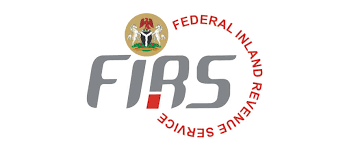
by Legalnaija | Apr 19, 2021 | Uncategorized
Introduction
The Federal Inland Revenue Service (“FIRS”), in a Public Notice on the Deployment of Automated Tax Administration Solution (“the Notice”) published in the Nation Newspaper of March 31, 2021, gave notice to all taxable persons[1] and the general public of the FIRS’ intention to connect its Automated Tax Administration System (“ATAS”) to access the data[2] of taxable persons stored in any electronic device maintained by any relevant person(s) or their agents[3], for tax purposes, not earlier than 30 days of the date of publication of the Notice.
The implication of the foregoing is that banks, employers, service providers and all other entities, companies or organizations in possession of the financial information of taxable persons in Nigeria must grant the FIRS access to such information or risk the penalties stated in Section 26(3) of the Federal Inland Revenue Service (Establishment) Act (“the FIRS Act”).
A corollary to this, however, may be a possible breach of the data protection/privacy obligations owed by these “relevant persons” to the taxable persons.
This paper seeks to examine dicey issues emanating from the Notice vis-à-vis the extant data protection/privacy laws in Nigeria.
Data Protection Regime in Nigeria
While there are a number of laws regulating data protection in Nigeria, the Nigeria Data Protection Regulation, 2019 (“the NDPR”) is the most comprehensive legislation on the subject. In May 2020, the National Information Technology Development Agency (“NITDA”) issued the Guidelines for the Management of Personal Data by Public Institutions in Nigeria, 2020 (“the Guidelines”) which, amongst other things, regulates the sharing of personal data[4] between public institutions or between private institutions and public institutions. The Guidelines is the focus of this paper.
Prefatorily, it is to be noted that the NDPR protects only the personal data of natural persons. In that context therefore, companies, trustees, business names and other organizations not being natural persons are not protected by the NDPR and by extension, the Guidelines. However, they also form the basis of this discourse given that they control the personal data of data subjects who are affected by the Notice.
Sharing of personal data under the Guidelines
The Guidelines permits private institutions to share personal data of interest in their possession with Public Institutions upon request[5] and insofar as the provisions of the Guidelines are satisfied. Some of the specific requirements for the validity of such request are that the request must be signed by the Chief Executive Officer of the Public Institution, state clearly the purposes for which the informationis sought from the private institution, provide evidence of the digitalization of the database of the Public Institution and upon an undertaking provided by the Public Institution that it shall protect the information from unauthorized third parties and shall not deanonymize the information shared.[6]
Further, Paragraph 2.6 of the Guidelines mandates Public Institutions desirous of obtaining personal data from private institutions to demonstrate compliance with international information security standards such as ISO 27001:2013, compliance with the NDPR, conduct a Data Protection Impact Assessment and retain the services of a Data Protection Compliance Organization.However, the FIRS is not on NITDA’s list of compliant organizations raising the presumption that it is not NDPR compliant.[7]
What is more, Paragraph 5(b) of the Guidelines mandates private institutions to which a request is made to evaluate same with a view to ensuring that it complies with the NDPR and to seek NITDA’s clarifications where it is unable to ascertain the propriety of the request. However,paragraph 5(d) seems to negate paragraph 5(b) by stating that the latter paragraph shall not apply where the request is aimed at the enforcement of law. Thus, given that the Notice relates to the enforcement of the FIRS Act, private institutions may be required to comply with the Notice.[8]More so, the NDPR permits the processing or disclosure of personal data where such disclosure is statutorily required or is expressly required by a regulatory body, such as the FIRS.
Conduct of a Data Protection Impact Assessment
One important consideration for the FIRS is to ensure that it conducts a Data Protection Impact Assessment (“DPIA”) before it deploys its ATAS, as planned. The importance cannot be overstated. This is driven by the fact that, by deploying its ATAS, the FIRS assumes the role of a data controller to data controllers as they will have access and control of data hitherto controlled by companies and other relevant data controllers. This invariably will put the data of all Nigerians in the control of the FIRS. By Paragraph 1(viii) of the Nigeria Data Protection Regulation, 2019: Implementation Framework, 2020 (“the Implementation Framework), data controllers must conduct a DPIA where they intend to embark on a new activity particularly one that will involve an intense use of personal data.
Given that the data sought to be accessed by the FIRS was initially supplied to the “relevant persons” for purposes other than as now required by the FIRS, it is suggested that both the FIRS and the relevant persons (as data controllers) should collaborate to ensure compliance with Paragraph 4.1 of the Implementation Framework.
It is further suggested that NITDA should exercise its powers under Paragraph 4.2 of the Implementation Framework to request the FIRS to submit its DPIA with respect to the planned deployment of its ATAS.
Compliance with the Notice
Any sharing of personal data with a Public Institutions is required to be by encrypted means or other methods which obscure such data.[9]
In light of the FIRS’ Notice under consideration, relevant persons to which the Notice relates may, as a preliminary step, seek assurance from the FIRS with regards to the matters in Paragraphs 2.6, 4 and 6 of the Guidelines[10] and/or may seek advice from NITDA on whether or not to comply with the Notice.
Where this done, the relevant persons/data controllers should isolate the data sought by the FIRS into an encrypted database to which the ATAS may be connected.[11] Taking these steps is precautionary on the data controllers who thus, have given themselves a good defence in the event of breach of their data as a result of the FIRS’s processing of their personal data.
Upon compliance with the Notice, data controllers are required to provide NITDA with details of the nature of personal data of data subjects to which they have given the FIRS access to in line with Paragraph 5(c) of the Guidelines.
REFERENCES
[1]Which includes individuals, trustees, partnerships, companies, corporations, etc
[2] Which shall include information of taxable persons related to Point of Sale Terminals and other invoicing platforms used by taxable persons
[3] Relevant persons in this regard contemplates the data controllers of the data sought to be connected to the ATAS who by the Notice are also required to grant the FIRS access to all its electronic devices used to store the personal data of taxable persons.
[4] Personal data means any information which of itself or when combined with other information, can be used to identify a specific natural person (“data subject”). In this context, personal data may range from names, email address, location, tax identification number, financial records, name of employer, etc. of data subjects.
[5]In this regard, does the FIRS Notice qualify as a request? This question begs for an answer
[6] See paragraphs 4 and 6 of the Guidelines.
[7]Although this may be attributable to the fact that NITDA’s list of complaint Organizations is yet to be updated
[8]This is however a most curious case. Where the presumption that the FIRS is not NDPR compliant is true, should private institutions go ahead to comply with the Notice? Has the FIRS conducted a data protection impact assessment on the planned connection of its ATAS to the servers of private institutions? If the only ‘request’ made by the FIRS is the Notice, then the request cannot be said to have complied with the Guidelines as, aside mandating private institutions to give it access to their servers, it makes none of the assurances required by the Guidelines and neither does it demonstrate that FIRS’ compliance with paragraphs 2, 3, 4 and 6 of the Guidelines.
[9]paragraph 4 (b) and (c) of the Guidelines prohibits the sharing of databases by private institutions with Public Institutions by means other than encrypted or other formats which murks such data.
[10]As well as seek information on FIRS’ data protection policies and its compliance with the NDPR
[11] Although not specifically required by either the Notice or the Guidelines, ethics dictates that the data made available to the FIRS should as much as is possible, be accurate.
 Abraham is an Associate at the Firm of Solola & Akpana. He is a member of the Firm’s Data Protection Compliance and Dispute Resolution Practice Groups. He is also a member of the Firm’s Corporate/Commercial Practice Group providing a wide range of legal representation and advice to a broad spectrum of clients in the Oil and Gas, Banking/Finance, Fintech and private sectors on various transactions and regulatory compliance.
Abraham is an Associate at the Firm of Solola & Akpana. He is a member of the Firm’s Data Protection Compliance and Dispute Resolution Practice Groups. He is also a member of the Firm’s Corporate/Commercial Practice Group providing a wide range of legal representation and advice to a broad spectrum of clients in the Oil and Gas, Banking/Finance, Fintech and private sectors on various transactions and regulatory compliance.
He has several articles on data protection/privacy law, international law and Intellectual Property Law published in his name and has routinely audited and filed data audit reports on behalf of several multinational and national companies in Nigeria, to NITDA.
He obtained his LL.B from Ambrose Alli University, Ekpoma and was called to the Nigerian Bar in 2019. He also holds a certification in Data Protection.
Abraham particularly has data protection, intellectual property, sports/entertainment law and fintech as his niche whilst also excelling in dispute resolution.
Reach Abraham at abrahamaigba@gmail.com; 08131993172

by Legalnaija | Apr 15, 2021 | Uncategorized
INTRODUCTION
One of the most exciting and promising frontiers of technology today is Artificial Intelligence (AI). Any conversation around technology is incomplete without a reference to AI. While the term AI has been around for decades, in recent times, its application across industries, from healthcare, business and education to banking, among others, is changing the way we live and work both remotely and in the traditional sense. The increasing ubiquity of AI can be attributed to greater processing power and the declining cost of achieving these tasks at increased speeds. The adoption of AI has been so rapid that stakeholders and market leaders in technology across industries can no longer ignore it for long-term and sustained financial growth.
DEFINITION OF TERMS
Artificial Intelligence (AI) refers to the simulation of human intelligence in machines that are programmed to think like humans and mimic their actions. AI is intelligence, demonstrated by machines, unlike the natural intelligence displayed by humans and animals, which involves consciousness and emotionality.
Artificial intelligence (AI) is a wide-ranging branch of computer science concerned with building smart machines capable of performing tasks that typically require human intelligence. In simpler terms, it is making computers think like humans. The term is used to describe machines that mimic cognitive functions such as learning and problem solving.[1]
Business disruption refers to any innovation within an industry that radically and lastingly changes the way all companies in that industry operate. Disruption in business causes radical shifts in industries by offering unique, niche, more affordable, or untapped solutions to old or new problems. Sometimes, disruption upends existing markets; other times, it creates entirely new ones.
If you have ever thought about a piece of popular new software, app, or tech-based product that has skyrocketed in use recently, it’s likely that at some point, “you encountered it being described as “disruptive”. An example that will readily come to mind is Netflix, all other streaming services which are in the process of an ongoing disruption in the entertainment industry which are largely influenced by the slow extinction of video rental stores and are now responsible for the ever-growing cancellation of cable subscriptions worldwide.
CURRENT TRENDS IN ARTIFICIAL INTELLIGENCE
Technology has proven time and time again that it has come to stay, from the advent of computers, to mobile phones, to digitalization and now to Artificial Intelligence. The industry has gone through various degrees of failures and successes and it has finally picked up to the extent that it has started to affect and transform our way of doing business.
AI has begun already to reshape our modes of doing business in every major sector. AI is already being put to use to help with making data based decisions and synthetization on a scale much larger and faster than the human brain could accomplish. It has come to assist and aid with easier and faster ways of running the business and to increase productivity. Some of the ways AI is disrupting business and increasing value are:
- Data Access
Data is allowing AI be more adaptable. Data access enabling universality is one of the recent Artificial Intelligence revolutions. Reliable and accurate information helps businesses shift to AI-powered automated decision making. It has helped to cut cost of operation, labor saving processes, and improved the research capacity of organizations.
Data management systems and AI work hand in hand. When AI becomes fixed within and throughout the system, it has the potential to improve database query accuracy and performance, and to make maximum use of system resources, it is not limited. By executing queries in a more efficient manner, enterprises can lower the time taken to generate insight and improve business decisions.
For example, developers of the autonomous car software can access a lot of driving data without driving the vehicles. Soon, we will witness a drastic increase in the application of Artificial Intelligence in real-world situations. As AI becomes more sophisticated, it will cause cost-effective and widespread availability of crucial data.[2]
AI also helps in metadata repositories, that is the repository that provides a consistent and reliable means of access to data. AI powered programs can actively learn from expert user input and suggest terms based on previous human actions. The system can recognize the similarity between items in the data catalog and make suggestions on business terms to be assigned.
- Market Prediction
Artificial Intelligence is going to assist businesses in the use of information to prepare for outcomes and behaviors thus being more proactive. The biggest AI trend in marketing in 2020, is increasing focus on providing personalized services.
One of the most common ways that AI can do so, is through analysis of the activity of individuals online by the use of keywords. A business owner, for instance, may need insight on those in a certain area who search for the services they provide.
One of the primary benefits AI offers in these scenarios is the capability to provide real-time updates about your audience, allowing you to better personalize the way you target them.
- Customization and Marketing
The use of AI is helping companies and business to be able to personalize their services to their customers and to understand clients and their preferences more, due to the use of data. One of the primary benefits of AI, is that it is capable of providing real time information about your clientele which would allow you as a business owner to have more effective ways of targeting them.[3]
One of the most common ways that AI can do so, is through analyzing the online activity of individuals who search for certain keywords. A restaurant, for instance, may need insight on the demographic information associated with local customers who search for foods they provide.
One of the primary benefits AI offers in these scenario is the capability to provide real-time updates about your audience, allowing you to better personalize the way you target them. Citing Netflix again as an example, the streaming outlet uses AI to keep their customer base interested by making movie recommendations for their customers using their watching history or search history.
- Boost Cybersecurity
AI could soon be integrated with Cybersecurity, enabling better defense of data and networks from attacks and security solutions for end-users. The ability of AI to analyze a lot of information over a short period of time means threats can be detected a whole lot faster and more accurately. From tracking and preventing phishing, AI technology will boost the security abilities of all systems. In the future, AI will be able to predict if a transaction is fraudulent or not, thus preventing all types of cybercrimes, and increasing the system’s vigilance.[4]
The ability to analyze massive amounts of data using AI can pave a way for the development of systems capable of reducing cyber- attacks. Some AI programs can be used to identify unwanted data and noise which aid security experts to understand the cyber environment in order to detect and correct abnormal activity.
Similarly, the implementation of AI for cyber security solutions will help to protect organizations from existing cyber threats and identify new types of malware.
This has become even more important given the fact that, majority of our transactions are done over the internet, and it has become essential that adequate tools are employed to prevent data breach and protect our information.
CONCLUSION
These are some of the ways AI is causing disruptive innovation. It is clear that, there is a disruption of what the market used to be and creation of whole new market. Given a few years and not only with the value given by AI have improved, it would also drastically have changed the mode of operating businesses, delivering services and customer relationship. It is important that as business owners and professionals we begin to adapt and adopt the changes.
If left unchecked, these disruptions caused by AI may have enormous consequences for societies. This is enough reason for policymakers to look closely at technological progress; what it means for their countries and how best to intervene. Policies are needed to help workers adapt to the new reality and to ensure their participation in the benefits arising from technology.
However, despite continuing advances in computer processing speed and memory capacity, there are yet no programs that can match human flexibility over wider domains or in tasks requiring much everyday knowledge.

Mr. Oyetola Muyiwa Atoyebi, SAN is an exceptional Technology lawyer and thought leader with over a decade’s worth of experience in legal Practice and technology. He has facilitated numerous transactions and given countless legal opinions as regards tech in Nigeria, his outstanding performance has attracted international recognitions and awards. He is the youngest lawyer in Nigeria’s history to be conferred with the highly coveted rank of a Senior Advocate of Nigeria (SAN).
He is the Managing Partner of OMAPLEX Law Firm, an established law firm driven by Technology innovation. As an expert in emerging areas of law practice, he has core competence in information technology, cyber security, Fintech, Robotics and Artificial intelligence. He is described to be the go-to person when it comes to issues around tech.
The learned silk is best characterized as a diligent, resourceful and yet humble individual who is revered for his highly analytical and pragmatic approach to solving legal problems as well as an unwavering commitment to achieving client goals. Indeed, his hard work and dedication to his clientele sets him apart.
Beyond his interests in law, the learned silk is an avid golfer and a tech enthusiast.
[1] https://www.webopedia.com/definitions/ai/
[2] https://www.analyticsinsight.net/artificial-intelligence-trends-in-2020/
[3] https://www.analyticsinsight.net/artificial-intelligence-trends-in-2020/
[4] https://www.ibm.com/downloads/cas/MGJ2DLQV
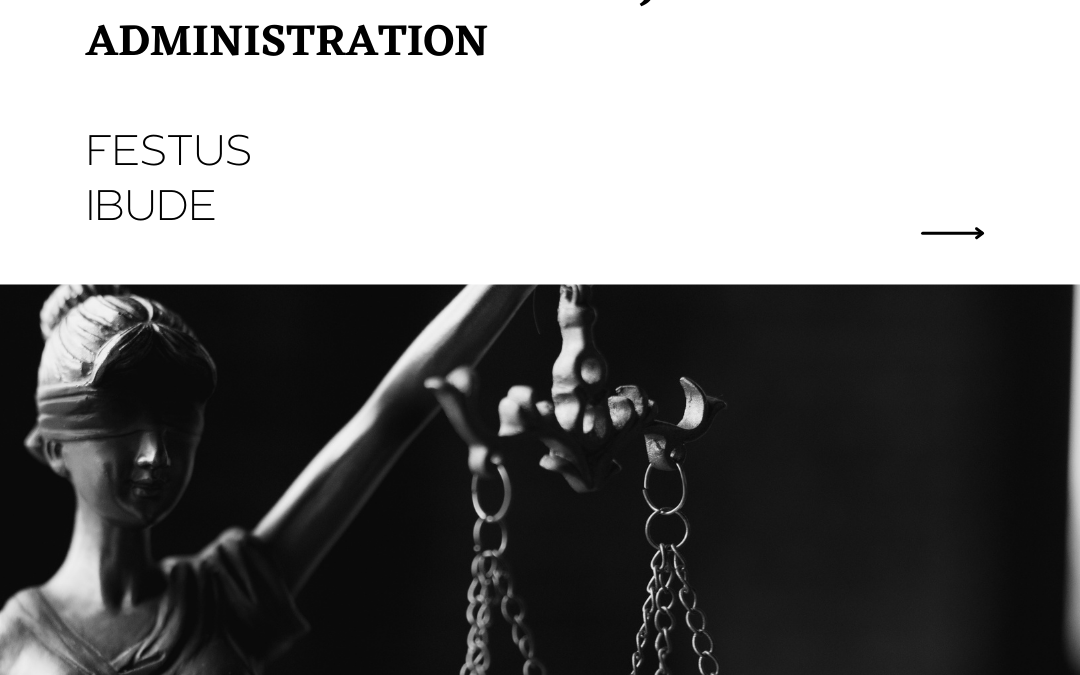
by Legalnaija | Apr 15, 2021 | Uncategorized
INTRODUCTION
The administration of justice as a system tries to maintain a core balance between the search for truth, the fairness of the process and ensuring justice. To this end, one of the major cardinal principles of criminal jurisprudence is that an accused person must be presumed to be innocent until the contrary is proved by credible and legal testimony beyond reasonable doubt. If there is a single principle of criminal jurisprudence that is well rooted and jealously guarded, it is that an accused person must in every case be presumed to be innocent unless and until the contrary is established. This is enshrined in the 1999 Constitution of the Federal Republic of Nigeria, in Section 36(5). This principle forms the foundation of our criminal system, of which no departure is accommodated. In the celebrated case of Woolmington v DPP[1], it was referred to as the “golden thread” that runs throughout criminal law. It was held that; (more…)
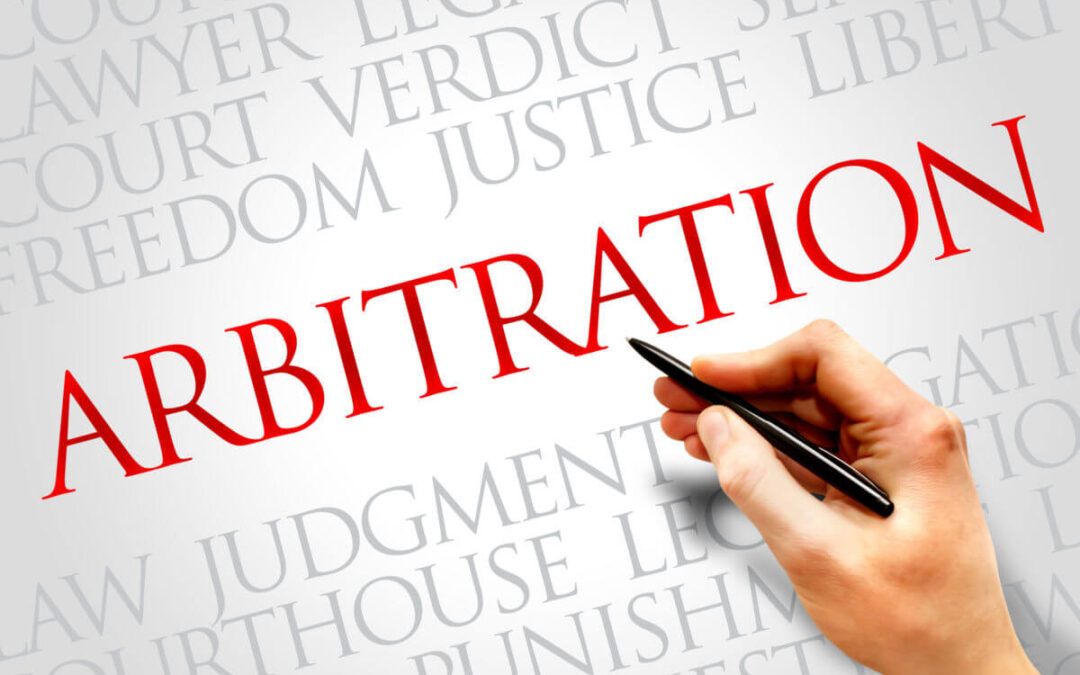
by Legalnaija | Apr 13, 2021 | Uncategorized
OBJECTIVE
This paper will examine the rules of ethics applicable to Counsel in International Commercial Arbitration, the dilemma of applying divergence rules of ethics and provide recommendations on the way forward.
INTRODUCTION
Regulating Counsel ethics has been a burning issue in the realm of international arbitration. Primarily, lawyers are regulated by the rules of ethics at the place they are licensed to practice. A seat of arbitration may be different from the jurisdiction where a lawyer is licensed to practice. It is difficulty therefore to determine which law should regulate lawyers’ conduct in arbitration; should it be the domestic regulation or the ethics obtainable at the seat of arbitration, or institutional rules or a new uniform rules. Often times, parties in arbitration are represented by non-lawyers, the question then is should the rules of ethics for lawyers apply to non-lawyers? These have led to the application of conflicting rules and norms in international arbitration. This paper will address these questions.
LAWYERS ETHICS IN INTERNATIONAL COMMERCIAL ARBITRATION
In the words of Mosk, “Parties in arbitrations can represent themselves or can be represented by lawyers, legally trained representatives or non-lawyers, such as corporate officers and technical advisors. Generally, except for small or specialized commercial arbitrations, parties in international arbitrations have legal representation. Some national laws require parties in international arbitration to establish that counsel is authorized to act on their behalf. This was the practice of the Iran-United States Claims Tribunal”.
As it can be seen above both lawyers and non-lawyers are eligible to represent parties in an arbitration proceedings. Just like in national courts where conducts of lawyers are regulated with respect to the mode of tendering evidence, courtesy and respect to court, cross-examination etc, it is pertinent also to regulate the conduct of lawyers in arbitration proceedings. The violation of the code of ethics by a lawyer in a court attracts sanction but the soft rules issued by arbitrators during preliminary stage lack ability to sanction disobedience.
Mosk noted that;
“Legal representation in international arbitration can involve the same ethical issues that arise in legal representation in other matters; for example, conflicts of interest, incompetence, lack candor, dishonesty, communications with opposing parties and arbitrators, improper compensation arrangements, and privileges. Different regimes have a variety of rules or laws applicable to these issues. The extent to which choice of law principles can govern professional conduct issues is not easily determined”.
It is important to regulate lawyers conduct in international arbitration but a code of ethics for counsel will have little impact on the segment of international arbitrations in which there is no counsel or the party representatives are non-lawyers. Industry arbitrations, such as commodities arbitrations, conduct their proceedings without counsel and governments are not always represented by attorneys
WHAT IS THE POSSIBLITY OF APPLYING UNIFORM RULES AND NORMS IN INTERNATIONAL ARBITRATION?
The dilemma of the application of divergence rules and norms in international arbitration was captured by Mosk when he stated that;
“Ethical norms do not exist as to many areas of behavior. There are some basic rules accepted almost everywhere. Examples include courtesy and respect for the tribunal members and opposing counsel, honesty and integrity, and the avoidance of unnecessary conflicts. Commonly, ethical precepts vary greatly from state to state. A uniform code may diverge from the standard of professional ethics in the country where the international arbitration is located, and the standard of professional ethics in the jurisdiction in which lawyers are licensed. Even within a state, codes of ethics are not easily administered. Within the United States, state codes may vary among themselves and with the American Bar Association code of ethics”.
As noted above it not is not enough to formulate uniform rules of ethics, a coordinated effort is needed to create an institution to enforce the rules. What is the essence of formulating rules without prescribing sanctions and taking further steps to create enforcement agency? Any rules of ethics for party representation without definite sanction is nothing but soft rules that is only persuasive.
According to Professor Garry Born;
“…when each state applies its own disciplinary rules, counsel may be unfairly subject to different standards in the same proceeding. But to relieve a lawyer of ethical obligations by the standards of the organization under which the lawyer is licensed to practice also is not workable. Relying on the rules in place at the seat of arbitration is not satisfactory; counsel generally are not familiar with the rules of conduct where the arbitration takes place…. The best resolution of this subject would be through the development of uniform international rules of professional conduct, applicable to counsel in international arbitral proceedings”.
The above view supports the uniform rules and norms set out as guidelines for party representation in international arbitration by the International Bar Association (hereinafter referred to as IBA).
The preamble to the IBA Guidelines on party representation captured the difficulty faced by counsel subject to different rules of ethics in international arbitration. The preamble stated thus;
“…The mandate of the Task Force was to focus on issues of counsel conduct and party representation in international arbitration that are subject to, or informed by, diverse and potentially conflicting rules and norms. As an initial inquiry, the Task Force undertook to determine whether such differing norms and practices may undermine the fundamental fairness and integrity of international arbitral proceedings and whether international guidelines on party representation in international arbitration may assist parties, counsel and arbitrators…. Unlike in domestic judicial settings, in which counsel are familiar with, and subject, to a single set of professional conduct rules, party representatives in international arbitration may be subject to diverse and potentially conflicting bodies of domestic rules and norms…”
RECOMMENDATIONS
The possible recommendations to the dilemma of applying divergence rules of ethics for counsel in international arbitrations are;
- Formulation of a uniform ethical code. This means involving an independent third party to formulate a uniform code of ethics for counsel. The most fruitful attempt thus far is the IBA Guidelines on Party Representation in International Arbitration or
- Institution-specific codes of conduct. This entails arbitral institutions themselves coming up with codes of conduct.
CONCLUSION
From the foregoing is obvious that, the proceeding in international arbitration is similar to that of national court’s proceeding and it should be regulated in the same way national courts are regulated. However, the challenge is based on the fact that domestic rules and norms regulates counsel behaviour and the seat of arbitration may be different from the jurisdiction where counsel practice. The rules of ethics that apply to counsel varies from one jurisdiction to another thus making it difficult for counsel to abide by different set of rules. It is therefore important to formulate uniform rules to arrest the ugly situation. Even though some writers opined that “the difficulty with such a regulatory framework is that any guidelines issued would “sit on top of” national ethical standards that apply to counsel. In that sense a uniform ethical code adds to, rather than cuts through, the morass of rules that counsel faces
References
- See the Preamble to “IBA Guidelines on Party Representation in International Arbitration” Adopted by a resolution of the IBA Council 25 May 2013 International Bar Association < https://www.ibanet.org > accessed on 4th April, 2021.
- Mosk Richard. M. “Attorney Ethics in International Arbitration” (2019) <https://www.bjil.typepad.com> accessed 2nd April 7, 2021.
- Mosk Richard. M. “Attorney Ethics in International Arbitration” (2019) <https://www.bjil.typepad.com> quoting R. Mosk & T Ginsburg “ Evidentiary Privileges in International Arbitration” (INT’L & COMP. L.Q. publication 2001)
- Mosk Richard. M. “Attorney Ethics in International Arbitration” (2019) <https://www.bjil.typepad.com> quoting Gary Born “International Commercial Arbitration” ((3d . 2009).

Okpi Bernard Adaafu Esq, LL.B, B.L, LL.M (in view).
Twitter: @OkpiBernard
Email: okpibernardadaafu@gmail
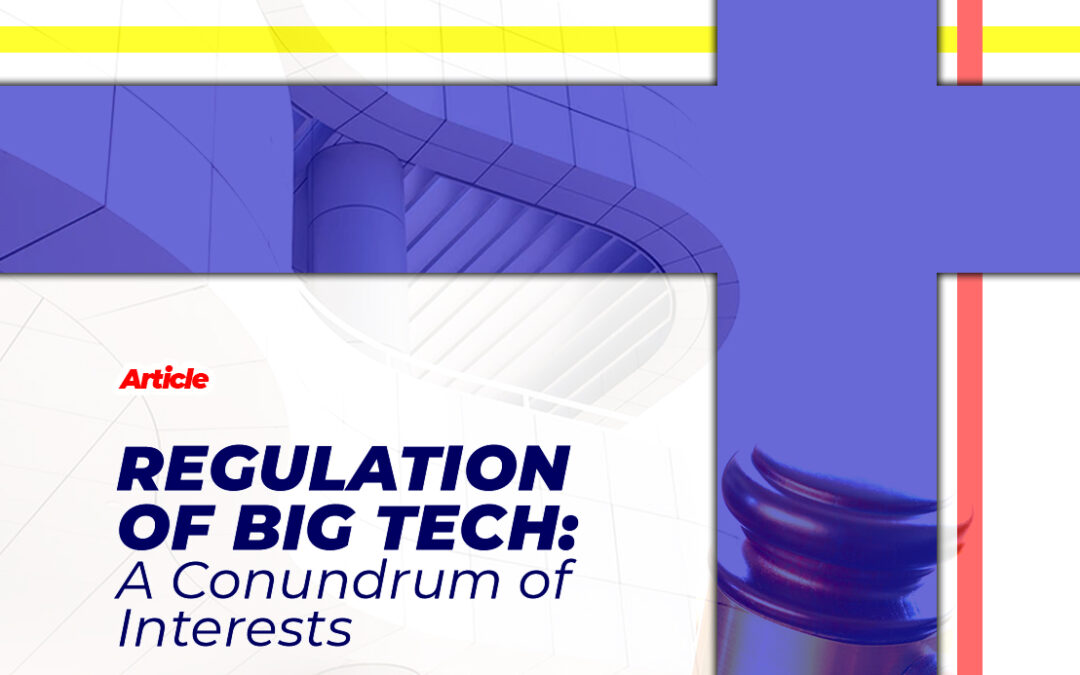
by Legalnaija | Apr 12, 2021 | Uncategorized
“Free speech no longer exists in America, it died with big tech”.Donald Trump Jr.
In a most unprecedented move, social media giants –Twitter, permanently suspended the account of former American President Donald J. Trump,following allegations that he had made inciting comments which led to violentprotests at the American Capitol building and its eventual occupation by protesters. Twitter’s action, has further fuelled ongoing conversations that social media platforms and indeed their CEOs, have become too powerful in their ability to shape public opinion in matters of politics, economy and other core facets of societal living.
This article is essentially a teaser. On the contrary, it seeks to establish that the arbitrary censorship of social media would reduce several democratic polities to pseudo dictatorships. In sharp contrast, it also beams a light on the several ills (for example increased hate speech, enhanced dictatorial tendencies of social media platform owners etcetera.) that befall society when social media is left unchecked. It concludes by opening a conversation on the plausible implementable solutions that can help achieve an equilibrium amongst the several actors in social media regulation.
Have Social Media Platform Owners Become Too Powerful?
On the 8th of January, 2021, the world awoke to receive the news that former American President, Donald Trump had been banned from Twitter for ‘inciting comments’ in the wake of the attacks at the American Capitol which left five persons dead. Commenting on the rationale for the ban, Twitter CEO Jack Dorsey via a Twitter post observed:
“I do not celebrate or feel pride in our having to ban @realDonaldTrump from Twitter, or how we got here. After a clear warning we’d take this action, we made a decision with the best information we had based on threats to physical safety both on and off Twitter. Was this correct?
I believe this was the right decision for Twitter. We faced an extraordinary and untenable circumstance, forcing us to focus all of our actions on public safety. Offline harm as a result of online speech is demonstrably real, and what drives our policy and enforcement above all.”
Indeed, the reactions trailing the ban of the Ex-President have been a mixed bag. German Chancellor, Angela Merkel regarded the move as ‘problematic’ as it, in her opinion, infringes on the right to free speech and expression. For the German Chancellor, such decisions to deny an individual a right to public expression is a subject matter that should be decided by laid down laws and designated government institutions.[1]Reprimanding the ban in a like manner, The United Kingdom’s Health Secretary Matt Hancock similarly observed: “The fact that a CEO can pull the plug on POTUS’s loudspeaker without any checks and balances is perplexing.”[2]
In whatever side of the divide one aligns, the uncontroverted fact remains that Social Media has transcended being a mere avenue of leisure and entertainment into a tool that can be utilized for the expression of free speech and other rights, as well as to galvanize public opinion on an array of public matters. It is the understanding of social media in this sense that has warranted the enactment of legislations by countries world over in seekingto strike a ‘balance’ on social media usage and abuse.
In its passage of theNetwork Enforcement Act, 2017, the German government became one of the first European countries to directly and specifically legislate on curbing the excesses of both social media ownership and abuse by users. By a combined reading of section 1(1), (2) and (3) of the Act[3], social media platforms with a minimum of two million users are mandated to establish channels that allow for the reporting of illegal content (which include contents on public incitement, sedition, terrorism etc.) which ought to be taken down by such platforms within 24 hours.
The law further requires such social media platforms to also publish bi-annual reports of their management of illegal content and the flagging of same[4] and stipulates a fine of up to $62,000,000 for companies that fail to comply.The German legislation in this regard has been criticized on two major grounds. First, critics opine that the 24-hour period giving to social media companies to review posts/contents that infringe on the Act is not sufficient to allow for a thorough process of review that guarantees meritorious regulation. Secondly, they also argue that the absence of an appeal process on most social media platforms after a user has been banned/suspended creates some sort of big-tech autocracy. Indeed, this further galvanises the position of world leaders like Angela Merkel who suggest that such procedures should be within the sphere of institutions of law.
How Much Regulation is Too Much?
In America, the acclaimed ‘home of democracy’ the approach to social media regulation has typically being, to allow social media platforms self-regulate by putting in place policies to track and remove offensive or illegal content. The free-hand allowed these companies essentially stems from the provisions of Section 230 of the Communications Decency Act 1996 which shields social media companies (like Twitter and Facebook) from liability for the content posted by their users.
In recent times however, there have been several outcries that tech giants were not doing enough to address the notoriety of illegal content on the internet. This pressure has ultimately pushed legislators in the US to reconsider the current arrangement of social media content regulation in the country. In 2020, the Eliminating Abusive and Rampant Neglect of Interactive Technologies Bill was introduced to the floor of the American Congress and it seeks to create exceptions to the provisions of the earlier mentioned Section 230 of the Communications Decency Act, 1996 by creating some sort of intermediary liability for tech giants[5]. This is in a bid to demand a higher sense of responsibility from social media giants in ensuring the serenity of their platforms.
Outside America however, the approach to social media regulation has been more stiff. Following terrorist attacks in Christchurch in 2017,the Australian Parliament enacted the Sharing of Abhorrent Violent Material Act, 2019 which amongst other things, warrants social media platforms to remove offensive, extremists and illegal content from their platforms ‘expeditiously’. A failure to comply attracts a fine of $2,100,000 or a 3-year imprisonment term when an individual is in default or a $10,500,000 fine/10%[6] of turnover when the defaulting entity is a corporate body.
The Australian legislation has come under heavy criticism for being rushed as it was made without due and wide consultations with the public. Critics have also stated that the requirement on social media platforms to ‘expeditiously’ remove offensive content as stated in the Act is too broad and undefined for a timeline, and makes the Act a ready tool for political witch-hunting in the hands of politicians.
Like the United States, the EU’s policy on social media content regulation has essentially being to mandate social media platforms to self-regulate. The Union has also responded by proposing a draft bill – the European Digital Act which seeks to mandate social media platforms to take down illegal content (on extremism, violence, child pornography etc.)within an hour. It further stipulates that whilst the failure to remove flagged content within an hour would not attract fines, the failure to remove same when flagged by a law enforcement agency would attract heavy fines. Indeed, this is obviously due to the fact that the later event would typically be on more authentic grounds.
The Nigerian Situation
In 2019, the Protection from Internet Falsehoods, Manipulations and Other Related Matters Bill, 2019 passed second reading on the floor of the Nigerian Senate. The Bill which is Nigeria’s first attempt at legislative regulation of social media content seeks to prevent the transmission of false statements/news and block access to finance for such online platforms. It also imposes a sanction of aN300,000 fine or a three-year imprisonment term on individuals in default of the law and a N10,000,000 fine on companies so found wanting. The Bill further empowers law enforcement agencies to mandate Internet Service Providers (ISPs) to block the internet access of persons alleged to have violated the provisions of the Act.
Perhaps, the most controversial element of the Bill is that it provides that the administration and enforcement of its provisions shall be vested in the Inspector General of Police. This has been heavily criticised by a vast majority of the Nigerian populace and opposition political parties who are of the opinion that the Bill seeks to deny the right to free speech and further empower the government and indeed politicians to victimize their political opponents and suppress critics. Consequently, at the Public Hearing held in respect of the Bill in March 2020, at the National Assembly, the Bill was largely rejected by civil society organisations and indeed members of the Nigerian public in attendance.
Nothing has since been heard of the Bill since the Public Hearing. The Senate has neither commenced a third reading of the Bill nor called for another Public Hearing. For some, it is testament that the will of the Nigerian people has prevailed over the wishes of a select few. Others, however still nurse the concerns that further attempts would be made in future to smuggle the Bill into the country’s legislations.[7]
The Way Forward
In today’s highly polarised modern society the issue of social media content regulation has become a hydra-headed conundrum. Governments and regional bodies across continents are posed with the question of how to curb the proliferation of the internet with illegal content without trampling on highly cherished citizen rights such as the freedom of expression and speech. It is firmly believed regardless, that any pragmatic approach to regulating social media must be one based on laws enacted after wide and broad based consultations with relevant stakeholders – the general public, social media users, the owners of social media platforms, security agencies and lawmakers.
This would ensure, that whatever laws are made would be a reflection of the true wishes of society and allow for little room for criticism on inclusiveness in the future. In a similar regard, it is also believed that the ultimate power to decide the termination of a person’s access to a social media should not be within the exclusive discretion of social media giants as this simply too much power!
It is suggested here that the value of a social media account (allowing an owner to achieve business advertising objectives and branding, political goals, activism etcetera) is of too much value to be treated trivially. Indeed, it should be equated with the status of a bank account ownership. Consequently, the denial of a person’s access to his account on the grounds of suspension/ban should be a subject contestable/appealable before the Courts of law.This truly would be allowing the law function as an agent of social engineering.

Authors: Mrs. OnyinyeChikwendu-Ikechebelu&Echoga Caleb
Mrs. Onyinye, is the Practice Manager of Omaplex Law Firm andmember of the project and asset finance group in Omaplex specializing in project and asset finance focusing on international aviation and shipping finance transactions.
While Echoga Calebholds a commendable legal expertise in intellectual property law, financial technology, and data protection and privacy law.
[1] Ryan Browne,‘Germany’s Merkel Hits out at Twitter over ‘Problematic’ Trump Ban’ <https://www.cnbc.com/2021/01/11/germanys-merkel-hits-out-at-twitter-over-problematic-trump-ban.html>Accessed, 25th March, 2021.
[2] Ibid.
[3] Network Enforcement Act, 2017.
[4] Section 2(1), Network Enforcement Act, 2017.
[5]David Morar and Bruna Martins, ‘ The Push for Content Moderation Around the World’<https://www.brookings.edu/blog/techtank/2020/09/21/the-push-for-content-moderation-legislation-around-the-world/>Accessed March 23, 2021.
[6] Section 474.34, Sharing of Abhorrent Violent Material Act, 2019.
[7]Mathew Ogune, ‘Protests Against Social Media Bill Persists in Abuja’The Guardian(Abuja, 10 March 2021) <https://guardian.ng/news/protest-against-social-media-bill-persists-in-abuja/> Accessed 10 March, 2021.

by Legalnaija | Apr 6, 2021 | Uncategorized

Lawbreed presents its special Easter Bumper sales tagged “season of great savings”. You get 10% on every 10K you Spend. You can also get up to 20% special discount consideration if you Call/Whatsapp: 08077011741/08077011730.It’s our season of love. Key into it Today while stock lasts!
This offer is available from now till 15th April, 2021
Call/Whatsapp/Text: 08077011730, 08077011741, 08077011755, 08023269613
Email: lawbreedorders@gmail.com /mails@lawbreed.com
www.lawbreed.com
* Terms and Conditions apply*



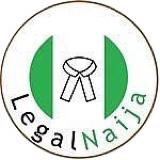


 Written by: Ibrahim Usman Wali
Written by: Ibrahim Usman Wali

 Abraham is an Associate at the Firm of Solola & Akpana. He is a member of the Firm’s Data Protection Compliance and Dispute Resolution Practice Groups. He is also a member of the Firm’s Corporate/Commercial Practice Group providing a wide range of legal representation and advice to a broad spectrum of clients in the Oil and Gas, Banking/Finance, Fintech and private sectors on various transactions and regulatory compliance.
Abraham is an Associate at the Firm of Solola & Akpana. He is a member of the Firm’s Data Protection Compliance and Dispute Resolution Practice Groups. He is also a member of the Firm’s Corporate/Commercial Practice Group providing a wide range of legal representation and advice to a broad spectrum of clients in the Oil and Gas, Banking/Finance, Fintech and private sectors on various transactions and regulatory compliance.







